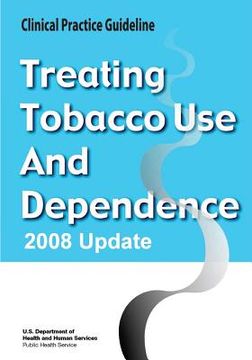Treating Tobacco Use and Dependence: 2008 Update - Clinical Practice Guideline (en Inglés)
Reseña del libro "Treating Tobacco Use and Dependence: 2008 Update - Clinical Practice Guideline (en Inglés)"
"Treating Tobacco Use and Dependence: 2008 Update"," is a product of the Tobacco Use and Dependence Guideline Panel, consortium representatives, consultants, and staff. This Guideline is an updated version that contains strategies and recommendations designed to assist clinicians; tobacco dependence treatment specialists; and health care administrators, insurers, and purchasers in delivering and supporting effective treatments for tobacco use and dependence. The recommendations were made as a result of a systematic review and meta-analysis of 11 specific topics identified by the Panel. The key recommendations of the updated Guideline are as follows: The overarching goal of these recommendations is that clinicians strongly recommend the use of effective tobacco dependence counseling and medication treatments to their patients who use tobacco, and that health systems, insurers, and purchasers assist clinicians in making such effective treatments available. 1. Tobacco dependence is a chronic disease that often requires repeated intervention and multiple attempts to quit. Effective treatments exist, however, that can significantly increase rates of long-term abstinence. 2. It is essential that clinicians and health care delivery systems consistently identify and document tobacco use status and treat every tobacco user seen in a health care setting. 3. Tobacco dependence treatments are effective across a broad range of populations. Clinicians should encourage every patient willing to make a quit attempt to use the counseling treatments and medications recommended in this Guideline. 4. Brief tobacco dependence treatment is effective. Clinicians should offer every patient who uses tobacco at least the brief treatments shown to be effective in this Guideline. 5. Individual, group, and telephone counseling are effective, and their effectiveness increases with treatment intensity. Two components of counseling are especially effective, and clinicians should use these when counseling patients making a quit attempt: Practical counseling (problemsolving/skills training); Social support delivered as part of treatment 6. Numerous effective medications are available for tobacco dependence, and clinicians should encourage their use by all patients attempting to quit smoking-except when medically contraindicated or with specific populations for which there is insufficient evidence of effectiveness (i.e., pregnant women, smokeless tobacco users, light smokers, and adolescents). Seven first-line medications (5 nicotine and 2 non-nicotine) reliably increase long-term smoking abstinence rates: Bupropion SR, Nicotine gum, Nicotine inhaler, Nicotine lozenge, Nicotine nasal spray, Nicotine patch, Varenicline; Clinicians also should consider the use of certain combinations of medications identified as effective in this Guideline. 7. Counseling and medication are effective when used by themselves for treating tobacco dependence. The combination of counseling and medication, however, is more effective than either alone. Thus, clinicians should encourage all individuals making a quit attempt to use both counseling and medication. 8. Telephone quitline counseling is effective with diverse populations and has broad reach. Therefore, both clinicians and health care delivery systems should ensure patient access to quitlines and promote quitline use. 9. If a tobacco user currently is unwilling to make a quit attempt, clinicians should use the motivational treatments shown in this Guideline to be effective in increasing future quit attempts. 10. Tobacco dependence treatments are both clinically effective and highly cost-effective relative to interventions for other clinical disorders. Providing coverage for these treatments increases quit rates. Insurers and purchasers should ensure that all insurance plans include the counseling and medication identified as effective in this Guideline as covered benefits.

